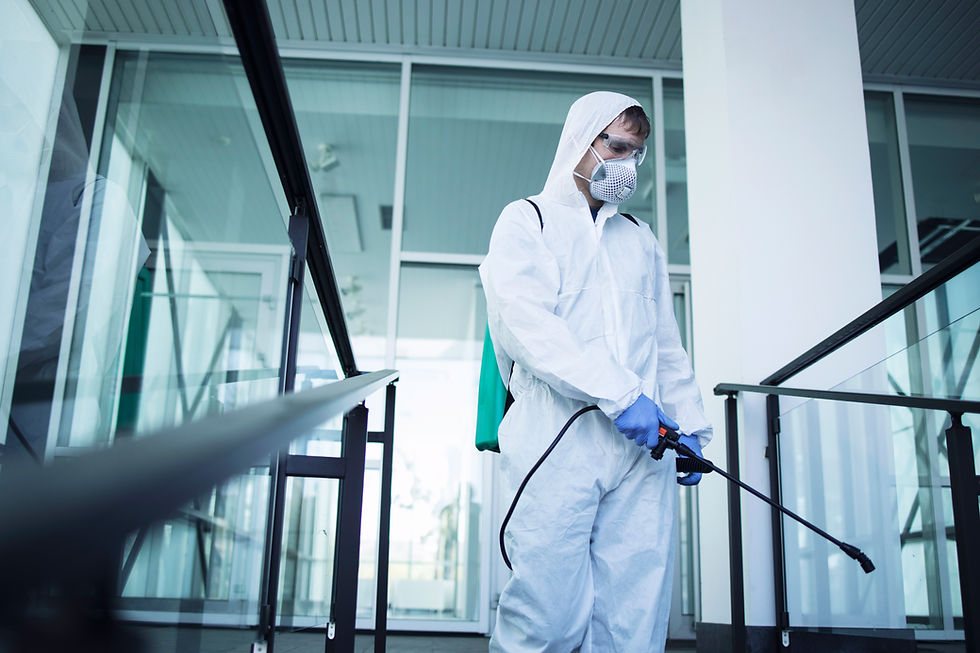A Step-by-Step Guide to Choosing Reliable Disinfecting Cleaning Services
- Jyoti Kumari
- Jan 2
- 3 min read
Updated: Mar 12

Maintaining a clean and sanitized environment is more important than ever. Whether it’s your home or workplace, finding reliable disinfecting cleaning services can make a big difference in keeping your space safe. But with so many options out there, how do you choose the right one?
In this blog, we will discover a step-by-step guide to help you make the best choice, types, and what are the differences between cleaning and disinfecting.
Types of Disinfecting Cleaning Services
Disinfectants play a crucial role in eliminating harmful microorganisms like bacteria, viruses, and fungi. Here's a detailed overview of some common types of disinfectants, including their uses, benefits, and best practices.
Alcohol-based disinfectants
Composition: Contain ethanol, isopropanol, or a combination of both.
Effectiveness: Highly effective against bacteria, viruses, and fungi. However, they are not suitable for killing spores.
Applications: Ideal for disinfecting non-porous surfaces, like:
Electronics (keyboards, smartphones).
High-touch areas (door handles, light switches).
Usage Tip: Ensure a minimum alcohol concentration of 70% for maximum efficacy.
Chlorine-Based Disinfectants
Composition: Contain chlorine compounds such as hypochlorites.
Effectiveness: Broad-spectrum germicidal action, effective against bacteria, viruses, and spores.
Applications: Commonly used for:
Pool water treatment.
Disinfecting large spaces like hospitals or public facilities.
Usage Tip: Follow dilution instructions carefully to avoid strong fumes or surface damage.
Bleach-Containing Disinfectants
Composition: Contain sodium hypochlorite (a type of chlorine).
Effectiveness: Extremely potent against bacteria, viruses, fungi, and spores.
Applications: Suitable for:
Cleaning kitchen countertops and cutting boards.
Sanitizing bathroom surfaces (tiles, sinks).
Usage Tip: Avoid using on porous surfaces or mixing with other cleaners (like ammonia) to prevent toxic fumes.
How to Choose Reliable Disinfecting Cleaning Services
Understand your Needs: Before searching for a service, think about your specific requirements. Are you looking for a one-time deep cleaning or regular maintenance? Different disinfecting services offer varied packages, so knowing what you need will help you narrow down your options.
Look for Experience and Certification: Not all disinfecting cleaning services are created equal. Choose a company that specializes in professional disinfection services and has trained staff. Check if they follow industry standards and use certified cleaning products to ensure maximum safety and effectiveness.
Check Reviews and Recommendations: Word-of-mouth and online reviews can give you a clear picture of the company's reliability. Look for feedback on their punctuality, professionalism, and the effectiveness of their disinfecting services. A company with consistently positive reviews is a strong contender.
Methods and Products: Reliable professional disinfection services should be transparent about the methods and products they use. Ensure they utilize EPA-approved disinfectants and safe techniques that won’t harm your family, employees, or pets.
Inquiries about customization: Every space is unique, and a one-size-fits-all approach might not work. Look for disinfecting cleaning services that offer tailored solutions based on your needs. This shows they are committed to providing personalized care.
Compare Pricing and Value: While cost is a factor, don’t compromise on quality. Compare quotes from different disinfecting services, but prioritize those that provide high-quality results over just the cheapest option.
Difference between Cleaning and Disinfecting
Cleaning: Cleaning involves removing dirt, dust, and debris from surfaces. This process typically uses soap, water, or detergent to physically eliminate contaminants.
Purpose: To make surfaces look tidy and remove visible grime.
Effectiveness: Reduces germs but doesn’t necessarily kill them.
Examples: Sweeping floors, wiping countertops, or washing dishes.
Disinfecting: Disinfecting targets and kills harmful microorganisms like bacteria, viruses, and fungi. This process involves using chemical agents specifically designed to destroy pathogens.
Purpose: To eliminate germs and reduce the risk of infection.
Effectiveness: Highly effective in killing germs but doesn’t clean dirt or dust.
Examples: Using bleach solutions or alcohol wipes on high-touch surfaces.
Conclusion
Choosing the right disinfecting cleaning services doesn't have to be overwhelming. You can ensure your space, stays clean, healthy, and well-maintained. Prioritize professionalism, transparency, and customization to find a partner you can trust for all your professional disinfection services needs.



Comments